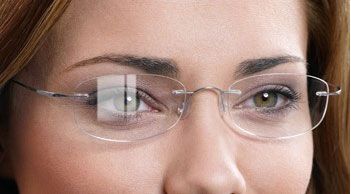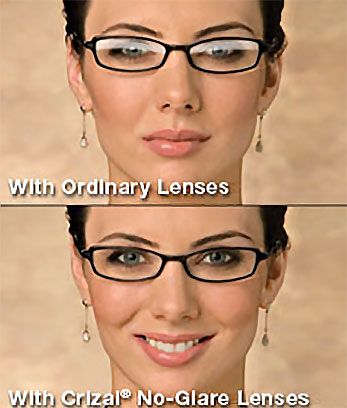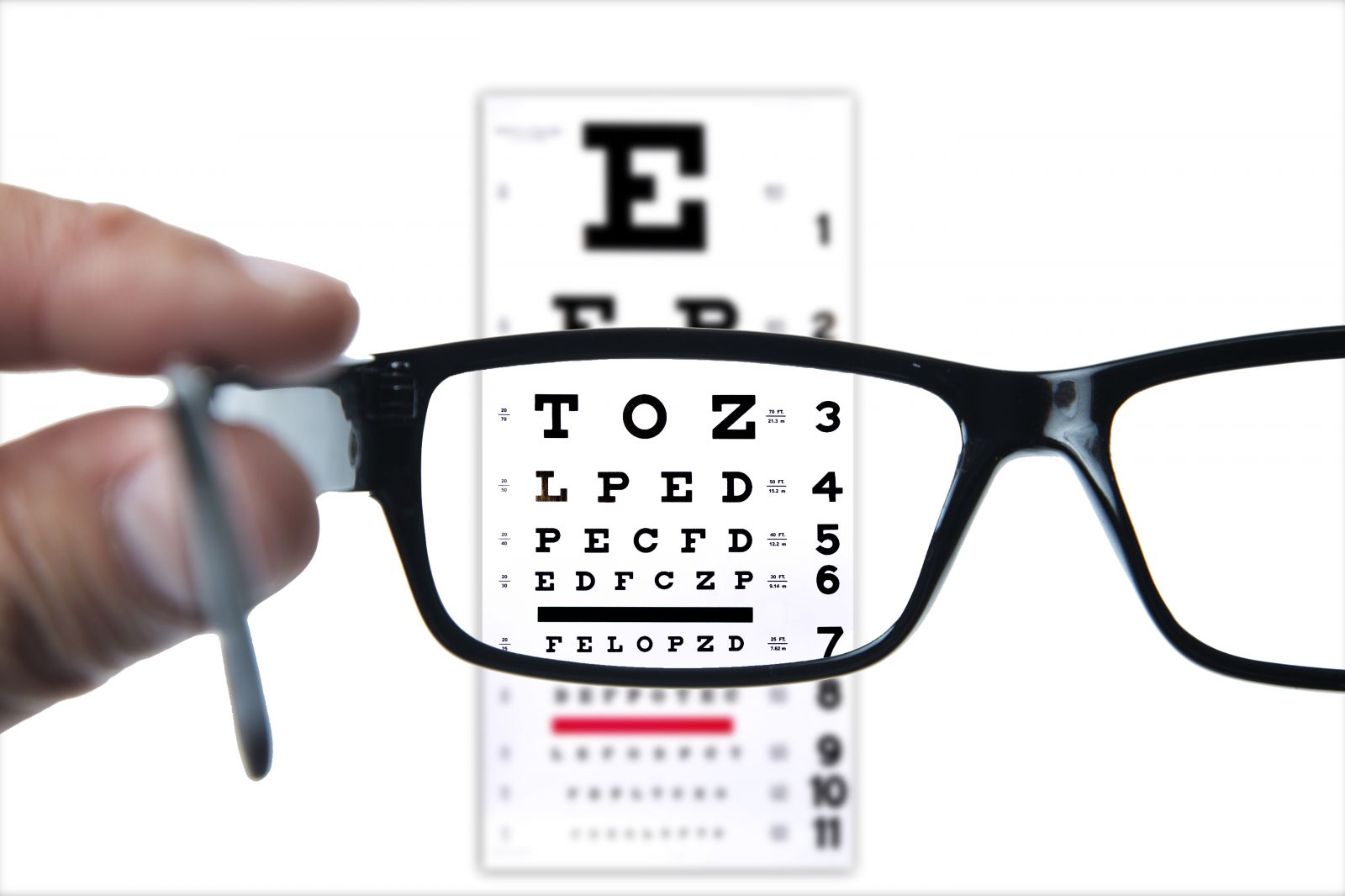Your glasses are probably worn more than any other article that you wear (shoes, hats, clothing, etc.), so they will probably take more use and abuse than anything else. Because of this, we advise coming in every six to twelve months to have them adjusted so they are comfortable and straight. Having your glasses straight and level is extremely important for all prescriptions, but especially so for bifocals, trifocals and progressive lenses.
Lens Materials
GLASS
PLASTIC
POLYCARBONATE
HIGH INDEX
* note – the percentage values above are not exact and meant only to illustrate the difference between the materials!
With our scratch coating, all lens materials are VERY scratch resistant and guaranteed for one year/one replacement.
Glare-free lens coating


Glare-free coating of eyeglasses will enhance your sight in natural and artificial lighting conditions.
The reflection and absorption of uncoated eyeglass lenses decreases the transmission of light by 8% (so around 92% of the light gets through). Glare-free coating allows the most possible light through, up to 99.5%. This will make your vision sharper and more defined, as if putting in a brighter light bulb.
The process applies is a very special multi‑layered coating to both the front and back lens surfaces. It eliminates reflections for you, so you will not be distracted by reflections. In addition, others looking at you will see your eyes clearly without reflections interfering.
People who benefit greatly from lenses with glare-free coating include:
- Public speakers
- Very nearsighted people, who are sensitive to reflection
- People sensitive to glare, especially from headlights
- First‑time wearers of glasses
- Computer terminal users
If you notice a colored hue on your lenses it is a normal effect of the coating. Care for them as you would plastic lenses, which includes rinsing first and wiping dry with a clean soft cotton cloth. Do not use any ammonia-based products on your lenses; it eventually eats away the coatings. You may also use specially manufactured glare-free cloth and cleaner provided at Golden Vision Clinic to give the final shine to your lenses.
Different lens materials work better with the glare-free coating so discuss the options with the doctor. At Golden Vision Clinic we guarantee to replace within one full year your Glare-Free coated lenses if they scratch regardless of the type of lens material.
We’ve also got prescription goggles for swimming! Give us a call at 303-278-20/20 to learn more
Multifocals
Presbyopia is the loss of your eyes’ focusing power. This is due to the accumulation of wisdom. Bifocals are designed to give you two different prescriptions in the same lens that allow to you see both far away and close. Typically, they are set so you will be able to see far away and near in the 13″ to 18″ range. But you will not have a specific section to help you focus in the intermediate 18″ to 40″ zone. A different design of lens may be important if you need to see in the intermediate zone. This could be a trifocal or a invisible progressive multifocal.
Each of the choices have advantages and disadvantages. Please keep in mind that glasses which correct presbyopia will be a compromise compared to how the eyes worked 10 or 20 years ago. You’ll have to learn to use and move your eyes and head differently.
BIFOCALS
(This is like a two speed transmission)
In this system you have two focuses: far and near. This enables you to read and do close work, and also see clearly far away without taking your glasses off. The biggest advantage of bifocal lenses is the convenience of not having to take your glasses on and off constantly. If you can see in the distance without glasses, wearing bifocals does not mean that you have to wear glasses all the time.
TRIFOCALS
(This is like a three speed transmission)
This lens system has three focuses. Far, for viewing something like a clock on a far wall; reading for 12″ to 20″; and the intermediate or in between range so you can see soup cans in the supermarket, playing cards, or the dashboard of your car. This is very important when you reach full presbyopia.
INVISIBLE PROGRESSIVE MULTIFOCALS
(This is like an automatic transmission)
Invisible progressive multifocals are a significant advancement in lens design. They have the no lines and a continuous range of clear vision from between your distance prescription to your near prescription. Because of this, you have a continuous range of clear vision from far away (driving and movies) through a middle range (playing cards and reading labels at arm’s length) to your near prescription (reading and sewing).

Our office has a sample set of invisible progressive multifocals for you to experience. Read with them, walk with them, and take your time exploring their advantages and disadvantages. Please note the progressive power channel leading down to the near prescription and their widths. Like regular bifocals, these lenses are designed for people who move their head more than their eyes when they look from side to side. ALL spectacle lenses have some degree of distortions and aberrations, but these are different in nature. Because of the unique curves on these lenses, to attain the progressive powers, some distortions and aberrations are generated on the lower outside edges.
Do not hesitate to return for adjustment of your frames if they are bumped, misaligned, or you have any concerns after first wearing them constantly for two weeks and allowing yourself time to adjust.
Our guarantee:
In the event that you are unable to adapt to these lenses in 3 weeks,
we will be happy to switch you to another style of lens.
Progressive lenses for computer users
For those of us who “live” in front of the computer, there is a better alternative to suit our visual needs than traditional progressive multifocal lenses. A lens design known as a computer continuum progressive lens.
The primary viewing area (the part of the lens directly in front of your eyes) of the Computer Continuum is the computer power, instead of the distance power as is the case with traditional progressives. The computer section is wider, deeper, and straight-ahead – so you do NOT have to tilt your head back to see through the computer range power. The bottom portion of the continuum lens has a larger reading area compared to the traditional progressive lens design. The extra room for the computer power and reading power means that the distance vision is smaller and located toward the very top of the lens. For seeing things past 10 feet your chin may need to be lowered to look through the top of the lens.
Computer Continuum lenses are ideal for computer users, administrative assistants, draft persons, accountants, artists, just to name a few.
The computer cubicle is another progressive lens option where the entire top half of the lens is focused at computer range rather than for distance vision. This allows the unique feature of a wider viewing area for clear vision on the computer screen and at reading distances.

Contact us at 303-278-20/20 or schedule an appointment online.
